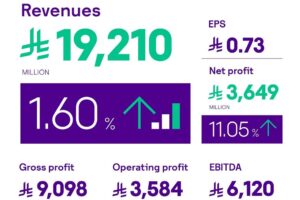The GSMA’s 2024 Mobile Net Zero report spotlights regional leaders in cutting carbon emissions since 2019, led by a 50% reduction in Europe. Operator emissions have fallen despite surging demand for connectivity and data, thanks to progress on energy efficiency and renewables.
The carbon emissions of mobile network operators[1] fell by 6% globally between 2019-2022, according to the GSMA’s fourth Mobile Net Zero report, published today at MWC Barcelona.
The report reveals regional variations in the reduction of operational emissions[2], with Europe leading the way with a 50% reduction. In North America, Latin America, the Middle East and North Africa, emissions fell by 20-30%. Although operational emissions rose in Greater China and the Asia-Pacific – the world’s largest and second largest mobile markets respectively – global emissions overall decreased, despite growing data usage.
Achieving the mobile sector’s target to reach net zero by 2050 relies on the industry cutting its emissions to 45% below 2020 levels by 2030. This means that overall emissions – including Scope 1, 2 and 3 – need to fall by around 7% per year up to 2030.
Recent progress shows that this is possible, as the target reduction rate has been exceeded over the past three years for operational emissions in Europe, North America, Latin America and MENA. The report notes that improved data and further analysis are needed to better understand ‘Scope 3’ trends, which relate to emissions from operators’ supply chains.
Progress on energy efficiency and renewable energy
According to the analysis, operational emissions fell despite surging demand for data and connectivity – the number of mobile connections globally rose by 7% between 2019-2022, while internet traffic more than doubled. The industry’s carbon reductions were largely driven by strong progress on energy efficiency and use of renewable energy.
Over half of the drop in emissions reported in 2022 was driven by improved energy efficiency efforts in networks, data centres and offices, as well as the electrification of fleets and generators. GSMA Intelligence’s Energy Efficiency Benchmarking project, in collaboration with 17 operator groups worldwide, aims to surface more data in this crucial area, quantifying network energy consumption, efficiency levels and fuel sources.
Meanwhile, renewable energy accounted for 33% of the electricity purchased by operators reporting to CDP in 2022, up from 14% in 2019. The report showed operators purchased a combined 50 TWh of renewable electricity in 2022, equivalent to the annual electricity demand of Qatar or Singapore, almost doubling their purchases from 2019. Without these purchases, operational carbon emissions are estimated to have been 15 million tonnes higher in 2022.
Accelerating progress to net zero
Moving the entire industry to net zero emissions by 2050 will require strong and concerted action from the industry, backed by supportive policies and investment from governments. The report concludes by providing recommendations and key action points for operators, their suppliers, and policymakers to accelerate climate action progress.
For operators and suppliers, the biggest opportunities are in energy efficiency, renewable energy and improving the circularity of supply chains and materials in the ecosystem. Governments, meanwhile, can play a key enabling role across these areas if they implement strong climate policies and ensure that energy markets and regulations encourage investment in renewable energy and grids.
John Giusti, Chief Regulatory Officer at the GSMA, said: “The evidence shows that the mobile industry’s commitment to net zero by 2050 is paying off. Despite surging demand for connectivity and data, the global carbon emissions of operators continued to fall. Although we see the strongest early lead from Europe in the race to net zero, and encouraging progress in the Americas and MENA, this is a race that everybody needs to win – or else we all lose. We see what is possible where there is a focus on energy efficiency and access to renewables.
We call for deeper engagement from governments to support the mobile industry in accelerating decarbonisation, with a concerted focus on encouraging investment in renewable energy, as lack of access to renewables in some regions creates a barrier for operators to continue their journey to net zero.”
Other key findings:
- Eight operators have submitted new near-term science-based targets to the Science Based Targets Initiative (SBTi) over the past year, bringing the total to 70 operators – nearly half of mobile connections globally. In addition, 53 operators are committed to longer term net zero targets.
- A growing number of operators are publicly disclosing their climate impacts, with 70 operators disclosing to the CDP in 2023, compared with 67 operators in 2022.
- The quality of disclosures has also improved, with a record 19 operators on the CDP’s A List in 2023. This means that over a quarter of operators disclosing to CDP received an A, compared with just 1.5% of all companies disclosing to CDP in 2023
- Three quarters of the mobile industry’s overall carbon emissions are Scope 3 value chain emissions, 90% of which originate from just five categories – purchased goods and services; capital goods; fuel- and energy-related activities; use of sold products; and investments.
- Increasing the circularity of mobile phones and network equipment is critical to reducing these Scope 3 emissions. To this end, the GSMA announced two new circularity targets in June 2023 to reduce the environmental impact of mobile phones by boosting their circularity through reuse, refurbish and recycling – as of January 2024, 15 operators have signed up to the new targets, representing a billion mobile connections.












